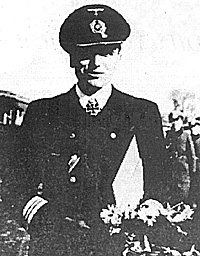
This photo was taken upon the official presentation of the KRETSCHMER MARCH. This march had not been heard since the end of WW II; until we got the music from OTTO, sent it to PROF. TOM MACKIN (146-A-1985) who scored it for his band & in 1993, for the first time in decades - the KRETSCHMER MARCH was heard. It is a great march, and it is part of our videotape H-23, our 1993 Convention in Chicago.
All historians of the U-Bootwaffe know, U-99 was sunk by HMS WALKER under command of Donald MacIntyre on 17 March, 1941. Here is what OTTO says about this day.
“.....that was the end of my boat, and what I experienced there was the same chivalrous attitude toward captives as I had experienced in submarine warfare. In that, we always acted without hatred towards our enemies. We had a job to do - it was sinking ships, not killing people.”
(HARRY’S NOTE - The veterans of U-99 and of HMS WALKER meet every few years for a formal dinner and dance. They alternate between Germany and England for these gatherings, and they prove definitely that former enemies can indeed be today’s friends.) We continue with OTTO’s narrative:
“Several times we had the opportunity to save survivors from the ships, but in our small submarines we could not add extra people. The best we could do was put them in life boats, give them food and a course for Ireland. Beyond that, we could do no more. I remember however, that one ship in convoy HX.72, the steamship SS BARON BLYTHSWOOD, broke in two and went down immediately. This was rarely the case, and nothing could help this crew.
In the morning after the attack, I left the convoy to go back to see if any ship had not sunk. If need be, I could finish the ship with gunfire. As I approached the area, I nearly passed a raft a few miles away, with one man standing and waving an oar with a shirt attached. It had a cartoon-like appearance to it. But, after sinking the ship, I brought him aboard. He had a moderate concussion and he didn’t even know the name of his ship, which was a very important item for our War diary (KTB). Difficult to extract from him, the ship’s ID. After showing him the silhouette book containing the silhouettes of various ships together with their names from Lloyd’s Register of Ships.
The survivor got some food, drink, dry clothes and some sleep. Then I located a life boat sail on the horizon, and went alongside. The look of the people in that boat! There were two whites - one officer and another at the helm in the aft end. The others were Far Eastern from Viet Nam; Anomites maybe. They looked as if they expected to killed or something. Then they were astonished when a man came with his own wet bundle under his arm and his own food, to be put into their boat. We then gave them a course and a good-bye, and sent them on their way.
The man who had been my guest, never knew that he had been aboard a German submarine. He thought that it was English. He told us that his ship had been sunk by ‘the Bloody Germans’ and now a British submarine had come and picked him up. We talked to him in English all of the time, those of us who knew English well enough. Also, I had an Italian Captain, Commander Longobardo who was well-known in the War, and was aboard to learn the contrast between submarine operations in the Mediterranean and the Atlantic. So, we had him aboard as an extra member of the crew. He didn’t know any German and I knew a bit of Italian, but not enough to talk - so we both decided to talk in English, the language of the enemy. So that is what he heard. The man’s name was Joe Byrne from England.
After fifty years, I now have a letter from someone in England, and now have an article from the local newspaper on Joe Byrne. He did survive, but later died. Very interestingly, I corresponded with the family and they were very grateful that he had survived - but we were very lucky to have seen him on his raft.
There was no war against men - only against ships, so it was only natural to save him.
Now, when I was taken prisoner, I was one year in British captivity. Like the War at Sea, our treatment was chivalrous. In March 1942, just a few months after Pearl Harbor, I was taken to Canada (Camp Borden, Ontario). There we received all of the papers, both Canadian and American.
The astonishing thing was to read the United States papers. The United States had been attacked by Japan at Pearl Harbor and of course, afterwards Germany had declared war on the United States. But it was very difficult for President Roosevelt to switch the will of the population from the Pacific to the Atlantic. From Japan to Europe - and try to convince them it was high time to stop the Germans from conquering the whole world.
It was astonishing to read that because we asked ourselves - with what? We had nothing! But in the end, the United States, starting with their troops in Africa and their subsequent invasion of Normandy, finished the war there; with Japan later.”
More Otto Kretschmer Interview
Back to KTB #117 Table of Contents
Back to KTB List of Issues
Back to MagWeb Master Magazine List
© Copyright 1995 by Harry Cooper, Sharkhunters International, Inc.
This article appears in MagWeb (Magazine Web) on the Internet World Wide Web. Other military history articles articles are available at http://www.magweb.com
Join Sharkhunters International, Inc.: PO Box 1539, Hernando, FL 34442, ph: 352-637-2917, fax: 352-637-6289, www.sharkhunters.com
